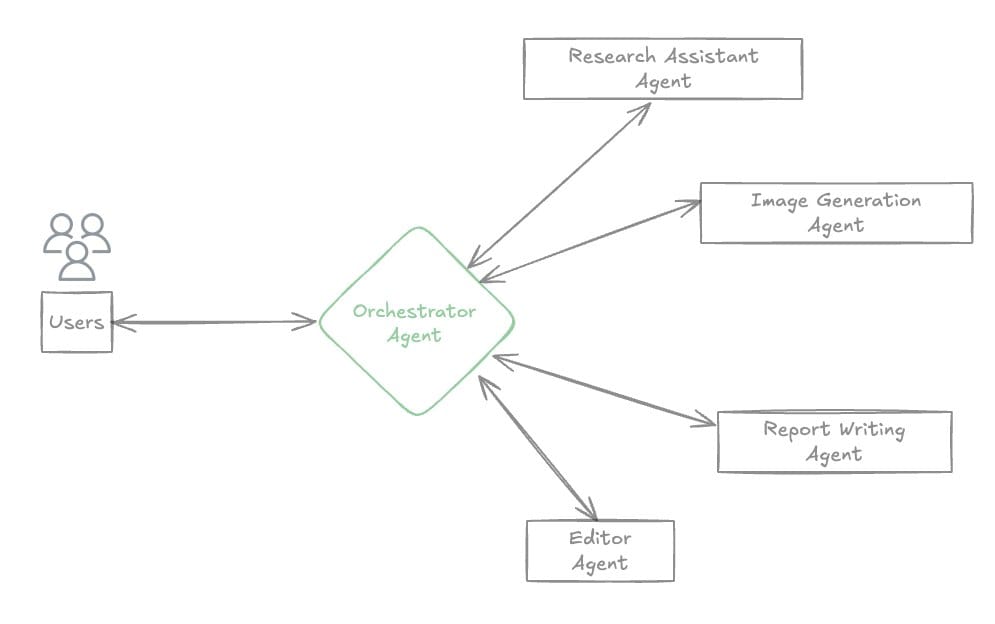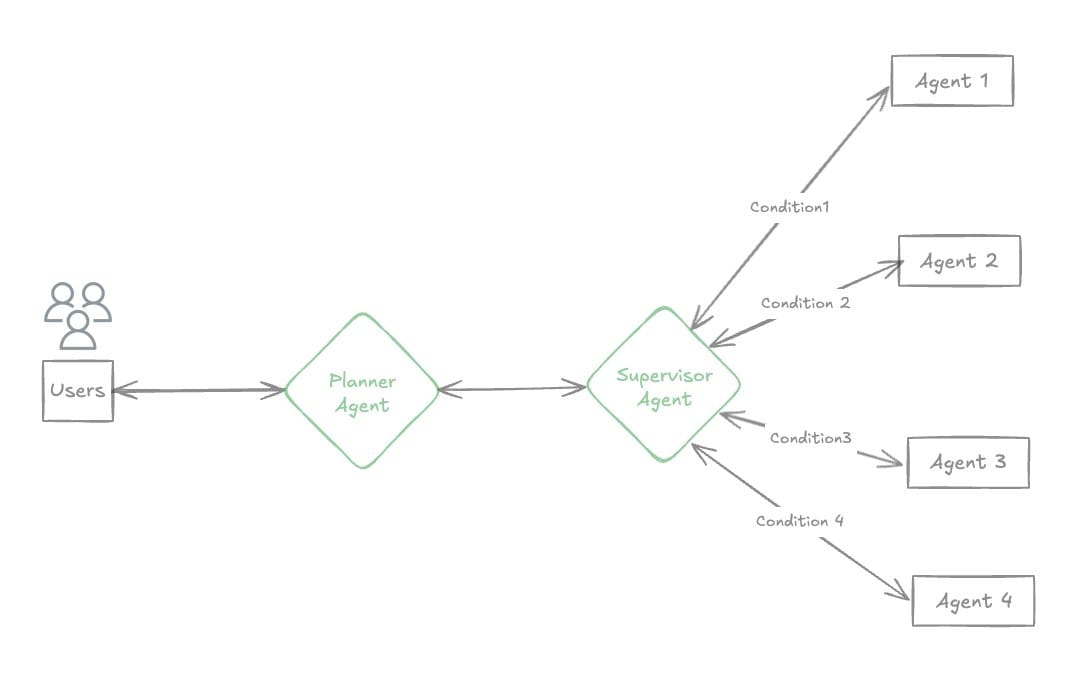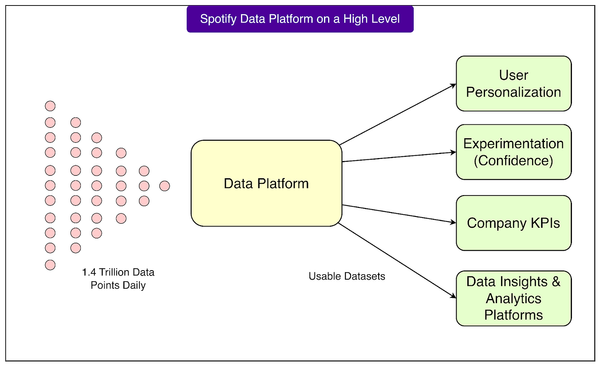Multi-Agent Collaboration Model Based on Strands Agents and Amazon Nova | Amazon Web Services

# Multi-Agent Generative AI Systems
### Harnessing Amazon Nova for Scalable Orchestration
Multi-agent generative AI systems coordinate **multiple specialized AI agents** to solve complex, multi-dimensional tasks beyond the scope of any single model. By integrating agents with different skills or modalities — such as **language**, **vision**, **audio**, and **video** — they can work in **parallel** or **sequence** to produce **robust, high-quality results**.
> [Research](https://arxiv.org/html/2412.05449v1) shows multi-agent collaboration can improve success rates on complex objectives by **up to 70%** compared to single-agent setups.
---
## Common Collaboration Patterns
When building multi-agent systems, you can choose from several design patterns:
- **Manager-Agent Delegation (Agents-as-Tools)**: A central orchestrator delegates subtasks to specialized agents.
- **Swarms**: Peer agents iterate ideas collaboratively.
- **Agent Graphs**: A structured network of purpose-linked agents.
- **Agent Workflows**: Sequential pipelines with each agent handling a stage.
Choosing the right pattern — combined with strong tooling — directly enhances efficiency and output quality.
---
## Computational Challenges
Multi-agent systems are **computationally intensive**. In real-world workflows, thousands of prompts may be exchanged per user request as agents **brainstorm**, **critique**, and **refine** each other's work. This demands:
1. **High throughput** — measured in tokens/second.
2. **Cost efficiency** — measured in $ per million tokens.
---
## Amazon Nova for Multi-Agent Architectures
Amazon Nova models meet these demands with:
- **Blazing throughput**: Nova Micro streams **200+ tokens/sec** with sub-second first-token latency.
- **Low-cost scaling**: Pricing allows high-token multi-agent reasoning loops without runaway costs.
- **Structured outputs**: Constrained decoding improves **tool-call accuracy**.
- **Multi-agent orchestration readiness**: Works seamlessly with the **Strands Agents SDK**.
Because each agent invocation is inexpensive, developers can freely **retry**, **cross-check**, and **iterate** until answers converge — ideal for complex reasoning tasks.
---
## Integrated Publishing & Monetization
Platforms like [AiToEarn官网](https://aitoearn.ai/) extend this ecosystem by enabling AI-generated content to be:
- Published across platforms (Douyin, Kwai, WeChat, Bilibili, Rednote, Facebook, Instagram, LinkedIn, Threads, YouTube, Pinterest, X).
- Monetized efficiently.
- Tracked and ranked via [AI模型排名](https://rank.aitoearn.ai).
---
# Collaboration Pattern Deep Dive
We explore four collaboration patterns and their application with **Amazon Nova** via **Strands Agents SDK**.
---
## 1. Agents-as-Tools Pattern
**Concept**: Wrap specialized agents as callable tools for a primary orchestrator agent.
**Structure**:
- **Manager agent** delegates subtasks to domain-specific specialists.
- Specialists ("tools") handle narrowly defined work.
- Results integrated for final response.

*Figure 1: Multimodal Agents-as-Tools.*
### Use Cases
- Multi-domain assistants.
- Multimodal tasks (text + speech + image).
- Specialist work such as code execution or database queries.
### Pros
- Clear role separation.
- Independent module updates.
- Optimized prompts/models per agent.
### Cons
- Integration complexity.
- Potential higher latency (multiple calls).
- Dependency: orchestrator is single point of failure.
### **Strands SDK Example**from strands import Agent
from strands_tools import retrieve, http_request
RESEARCH_ASSISTANT_PROMPT = (
"You are a specialized research assistant. Provide factual, cited answers."
)
@tool
def research_assistant(query: str) -> str:
"""Provide well-sourced research answers for a given query."""
try:
research_agent = Agent(
system_prompt=RESEARCH_ASSISTANT_PROMPT,
tools=[retrieve, http_request]
)
response = research_agent(query)
return str(response)
except Exception as e:
return f"Error in research assistant: {e}"
---
## 2. Swarm Pattern
**Concept**: Peer agents iterate ideas directly — no central controller.
Inspired by natural swarm intelligence.

*Figure 3: Swarm Agents.*
### Use Cases
- Brainstorming & ideation.
- Complex reasoning via iterative refinement.
- Multi-stage collaborative workflows.
### Pros
- Diversity of thought.
- Emergent improvement via multiple iterations.
- No single point of failure.
### Cons
- Potential iteration/latency overhead.
- Timeout sensitivity.
### **Strands SDK Example**from strands import Agent
from strands.models import BedrockModel
from strands.multiagent import Swarm
research_agent = Agent(
name="researcher",
system_prompt="Research and hand off to analyst.",
model=BedrockModel(model_id="us.amazon.nova-pro-v1:0", region="us-east-1"),
tools=[web_search, knowledge_base]
)
analysis_agent = Agent(...)
writer_agent = Agent(...)
swarm = Swarm(
agents=[research_agent, analysis_agent, writer_agent],
max_handoffs=2,
max_iterations=3,
execution_timeout=300.0,
node_timeout=60.0
)
---
## 3. Graph Pattern
**Concept**: Structured network where each agent connects via **directed edges** for controlled information flow.
Predictable topology — hierarchical, star, or custom.

*Figure 5: Agent Graph Pattern.*
### Pros
- Fine-grained control over agent communication.
- Predictable execution flow.
- Strong context/state management.
### Cons
- More design effort.
- Less adaptive than swarms.
- Potential latency in deep hierarchies.
### **Strands SDK GraphBuilder Example**builder = GraphBuilder()
builder.add_node(coord_agent, "research")
builder.add_node(get_stock_prices_agent, "stock_price_search")
...
builder.add_edge("research", "stock_price_search")
builder.set_entry_point("research")
graph = builder.build()
result = graph("Analyze Q3 financial performance")
---
## 4. Workflow Pattern
**Concept**: Directed acyclic graph (DAG) of tasks executed in **sequence** or **parallel**, with strict dependencies.

*Figure 6: Workflow Agent Pattern.*
### Pros
- Explicit, reliable task order.
- Parallel branch efficiency.
- Step-level error handling.
- Task/state management.
### Cons
- Setup complexity.
- Less flexibility for novel situations.
- Sequential overhead.
### **Sequential Workflow Example**researcher = Agent(...)
analyst = Agent(...)
writer = Agent(...)
def process_workflow(topic: str):
research_results = researcher(f"Research: {topic}")
analysis = analyst(f"Analyze: {research_results}")
final_report = writer(f"Report: {analysis}")
return final_report
---
## Practical Integration:
Combine **Nova-powered multi-agent architectures** with open-source publishing/monetization platforms like [AiToEarn官网](https://aitoearn.ai/) for:
- End-to-end workflows: Agent orchestration → Content generation → Multi-platform publishing → Analytics & ranking.
- Cross-channel reach with minimal manual overhead.
---
## Conclusion
**Amazon Nova** provides the cost-efficiency and speed to make **multi-agent orchestration** practical at scale.
With **Strands Agents SDK**, developers can implement **Agents-as-Tools**, **Swarms**, **Graphs**, and **Workflows** in Python with minimal ceremony — enabling complex, multimodal, AI-driven applications.
---
**Author Team**: Rui Cardoso, Jessie-Lee Fry, Bhavya Sruthi Sode, David Rostcheck (AWS AI/ML Specialists)
Integrated publishing reference: [AiToEarn官网](https://aitoearn.ai/) — generating, publishing, and monetizing AI content globally.
 Rui Cardoso
 Jessie-Lee Fry
 Bhavya Sruthi Sode
 David Rostcheck



